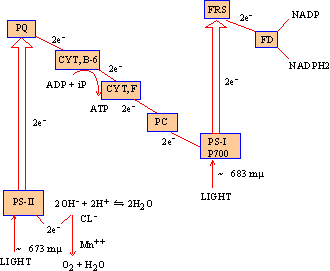|
PinkMonkey Online Study Guide-Biology

Figure 4.4 Diagrammatic representation of the non-cyclic process
(Z scheme)
b) Photoexcitation of PS II : Similarly, on receiving
photons of light, the chl-a (680) of PS II also gets activated and expels
electrons. As a result, it becomes ionized chl-a+. The high
energy containing electrons from PS II are first accepted by an electron
acceptor PQ (plastoquinone) and are then transferred along stet Electron
Transport System consisting of plastoquinone, cytochrome b6, Cytochrome
f and plastocyanin. Finally, the electrons are accepted by the ionized
chl-a+ of PS I. In this way, ionized PS I comes back to the
ground state and can again participate in the process.
(c) Photolysis of water : The ionized chlorophyll-a+ of PS II is brought back to the ground state with the help of the electrons made available through the photolysis of water.

(d) Formation of NADPH2
and liberation of O2 : During photolysis
of water, oxygen is released as a by-product. The 2 NADP receive 4e- from
PS I and 4H+ from the photolysis of water to form reduced coenzyme NADPH2

(e) Non-Cyclic electron transfer : In
this process, the movement of electrons is considered to be non-cyclic,
or unidirectional. This is because, the final electron acceptor is different
from the initial electron donor.
Initial electron donor Final electron acceptor

In this way, the light-induced electron flow is maintained continuously in the non-cyclic manner from water to NADP as follows

Because of the zig-zag path of the electrons (Figure 4.4),
the non cyclic process is also called ‘Z’ scheme electron transport.
(f) ATP formation : During the non-cyclic
transfer of energy-rich electrons through the Electron Transport System
from PS II to PS I, energy from the electrons is released. This is used
for the formation of ATP from ADP and H3PO4. This
is called non-cyclic photophosphorylation.
End products of non-cyclic process and the assimilatory
power : The end products are ATP, NADPH2 and O2.
Of these, O2 is liberated from the green plants. ATP and NADPH2
are used in the following dark reactions (phase II) for carbon assimilation(
i.e., reduction of CO2 to form carbohydrates). ATP and NADPH2
of light reaction are called ‘assimilatory power.
|